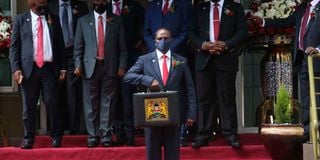Yatani toots Jubilee’s horn as he traces key milestones since 2013

Treasury Cabinet Secretary Ukur Yatani poses for a photo at Treasury House in Nairobi before heading to Parliament buildings for the reading of 2021/2022 budget statement on June 11, 2021.
What you need to know:
- Mr Yatani cited economic growth, increased jobs, higher revenue collection, access to credit for private enterprises and investment in local motor vehicle assembly plants over the past eight years.
Treasury Cabinet Secretary Ukur Yatani on Thursday sought to project the Jubilee administration’s achievements since it won power in 2013.
Mr Yatani cited economic growth, increased jobs, higher revenue collection, access to credit for private enterprises and investment in local motor vehicle assembly plants over the past eight years.
He praised Kenya’s economic resilience, saying it maintained an average of 5.6 percent growth between 2013 and 2019.
Despite the disruption by the Covid-19 pandemic, he projected economic growth of at least 6.1 percent by the end of 2021.
Kenyans are also getting richer, he argued, with per capita income increasing from Sh113, 000 in 2013 to Sh204, 000 in 2019, representing an increase of 80.4 per cent.
Employment opportunities
More jobs were also created in the country, the CS said, increasing from 755,000 in 2013 to 846,000 in 2019.
Mr Yatani revealed that credit in the private sector increased from Sh1.8 trillion in 2013 to Sh2.8 trillion last year.
This, as the Central Bank lending rates declined from 8.5 percent to 7 percent over the same period with the overall lending rates having declined from 17.3 percent in 2013 to 12 percent in 2020.
The country’s current account deficit improved from 8.8 percent of GDP in 2013 to 4.7 percent in 2020, a factor that has supported the stability of the foreign exchange market, he explained.
Other improvements
Mr Yatani commended the expansion in energy generation and connectivity that has seen 7.5 million households connected to electricity compared to 2.3 million in 2013.
Kenya’s revenue collection also marked an impressive improvement as it doubled from Sh900 billion in the 2013/14 financial year to Sh1.8 trillion in 2020/21 financial year.
The CS praised the recent development projects launched by President Uhuru Kenyatta, including the Lamu Port, the current rehabilitation of the metre gauge railway from Nairobi to Naivasha as well as from Nakuru to Kisumu.
He also cited the special economic zones in Ndogo Kundu, Naivasha and Kisumu.
The CS also praised the growth of the local assembling of vehicles and motor cycles sector.
Incentives, including the removal of excise duty on locally assembled goods, the duty free importation of assembling kits, reduced corporate tax from 30 to 15 percent for the first five years of operation, were cited as factors contributing to the massive growth in the sector.
Disease-free zone
So far, the government has approved 13 motor vehicle and 17 motorcycle assemblers in the country.
Mr Yatani revealed plans of developing a disease-free zone in the country to support export of live animals and also establish a fully-fledged meat processing plant.
There are also plans to set up a fish processing plant in Lamu and revamping of the Liwatoni fishing complex in Mombasa.
“This will provide ready market to livestock, increase farmers’ income and enhance meat value chain in the area,” Mr Yatani explained.
The plight of tea and coffee farmers, however, was not addressed, with the CS noting that the foreign exchange earnings to tea and coffee farmers have been declining over the years due to low productivity, high input cost, low levels of value addition and weak regulatory and institutional frameworks.





